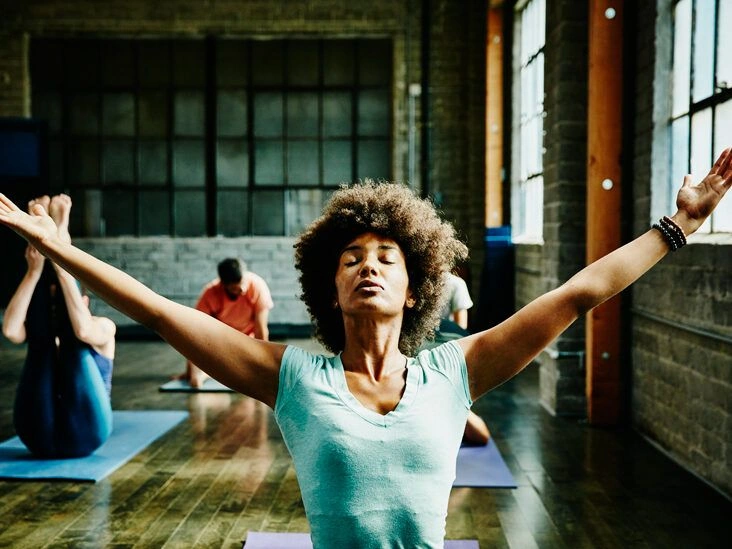A mix of yoga, stretching, and strengthening movements can gradually help correct your posture over time.
Keeping good posture matters for building strength, improving flexibility, and enhancing balance.
These may lower the chance of muscle and spinal injuries that lead to musculoskeletal conditions and can boost body-related feelings such as body image satisfaction and self-evaluation.
Some studies indicate that a regimen combining strengthening, stretching, and spinal/torso-lengthening exercises may assist in improving posture.
Below are 12 exercises to help enhance your posture.
1. Child’s Pose
Child’s Pose lengthens and stretches the spine, glutes, and hamstrings. It may also ease tension in the lower back and neck.
To practice this pose:
- Sit on your shins with knees together, big toes touching, and heels splayed out to the sides.
- Fold forward from your hips and walk your hands forward.
- Sink your hips back toward your feet. If your thighs don’t reach, place a pillow or folded blanket underneath for support.
- Gently rest your forehead on the floor or turn your head to one side.
- Keep your arms extended forward or rest them alongside your body.
- Breathe deeply into the back of your rib cage and waist.
- Stay in this posture for up to 5 minutes while maintaining deep breaths.


4. Standing Cat-Cow

This standing variation of Cat-Cow can help loosen tight areas in your back, hips, and glutes.
To do the movement:
- Stand with feet about hip-width apart and a slight bend in your knees.
- Extend your arms forward or rest them on your thighs.
- Lengthen your neck, tuck your chin toward your chest, and round your spine.
- Then lift your gaze, open your chest, and arch your spine in the opposite direction.
- Hold each position for five breaths.
- Repeat this flow for a few minutes.
5. Chest opener

Stretching and opening the chest can support better posture, especially if prolonged sitting causes your chest to collapse inward.
To perform this stretch:
- Stand with feet roughly hip-width apart.
- Bring your arms behind you and interlace fingers, pressing palms together. Use a towel if your hands can’t reach.
- Keep head, neck, and spine aligned while looking straight ahead.
- Inhale as you lift your chest toward the ceiling and draw your hands down toward the floor.
- Breathe steadily while holding for five breaths.
- Release and relax for a few breaths.
- Repeat at least 10 times.
6. High plank

High planks develop balance and strength in the core and back, both of which are key for maintaining good posture.
To do this exercise:
- Start on all fours, straighten your legs, lift your heels, and raise your hips.
- Keep your back straight and engage your abs, arms, and legs.
- Lengthen the back of your neck, relax the throat, and look down at the floor.
- Ensure your chest is open and shoulders drawn back.
- Hold for up to one minute.
7. Side plank

A variant of the plank, the side plank targets the muscles along your sides and glutes. Strengthening and aligning these areas supports your back and aids posture.
To practice this move:
- From a high plank, bring your right hand slightly toward center.
- Shift weight onto your right hand, stack your ankles, and lift your hips.
- Place your left hand on your hip or extend it upward toward the ceiling.
- Drop your right knee to the floor for extra stability if needed.
- Engage your abs, side body, and glutes while holding the pose.
- Keep your body aligned from crown to heels.
- Gaze forward or up toward your raised hand.
- Hold for up to 30 seconds.
- Repeat on the other side.
8. Downward-Facing Dog

Downward-Facing Dog is a forward-folding, restorative pose that balances the body. It can alleviate back discomfort while strengthening and aligning the back muscles.
To do this pose:
- Lie prone, press into your hands, tuck your toes, and lift your heels.
- Lift your knees and hips, bringing your sitting bones toward the ceiling.
- Slightly bend your knees and lengthen your spine.
- Keep your ears aligned with your upper arms or tuck your chin into your chest.
- Press firmly through your hands while keeping heels slightly lifted.
- Hold for up to one minute.
9. Pigeon Pose

This hip-opening pose can also free tension in the spine, hamstrings, and glutes.
To practice Pigeon:
- Start on all fours with knees under hips and hands slightly in front of shoulders.
- Bend your right knee and place it behind your right wrist, angling your right foot toward the left.
- Let the outside of your right shin rest on the floor.
- Slide your left leg back, straighten the knee, and rest the thigh on the floor.
- Ensure your left leg extends directly back rather than out to the side.
- Slowly lower your torso to rest on your inner right thigh, reaching your arms forward.
- Hold for up to one minute.
- Release by walking your hands back toward your hips and lifting your torso.
- Repeat on the other side.
10. Thoracic spine rotation

Gently opening the chest and rotating the upper spine can ease tightness while improving stability and mobility.
To do this stretch:
- Come onto all fours, then sit back onto your heels and rest on your shins.
- Place your right hand behind your head with your elbow pointing outward.
- Keep your left hand under your shoulder or bring it to the center and rest on your forearm.
- Exhale as you rotate your right elbow up toward the ceiling, stretching the front of your torso.
- Take a long inhale and exhale in this position.
- Return to the starting position.
- Repeat 5 to 10 times, alternating sides.
11. Glute bridge

Glute bridges activate and strengthen the glutes while easing lower back discomfort. This can improve hip and pelvic alignment, contributing to better posture.
To perform this exercise:
- Lie on your back with knees bent and feet about hip-width apart.
- Keep your feet roughly a foot away from your hips.
- Rest your arms alongside your body with palms facing down.
- Exhale as you lift your hips toward the ceiling, lengthening your spine.
- Hold the position for up to one minute.
12. Isometric pulls

Isometric pulls target the shoulders, arms, and upper back, building the strength needed to hold good posture.
To try this exercise:
- Sit in a chair with a soft back.
- Make a fist with each hand and extend your arms forward so they’re parallel to the floor.
- Exhale as you draw your elbows back toward your shoulders and squeeze your shoulder blades together.
- Breathe steadily while holding this contraction for 10 seconds.
- On an inhale, slowly return to the starting position.
- Repeat for one minute.
Frequently asked questions
Can you correct years of bad posture?
Improvements are possible, but set realistic expectations — change takes time and won’t be immediate.
If you don’t see posture improvements after several weeks of regular stretching and focused practice, consult a healthcare provider. They may suggest imaging like X-rays to assess spinal alignment and shape.
What exercise is best for improving posture?
The best exercise is one you’ll do consistently. That often means mixing various yoga poses, stretches, and exercises that focus on lengthening the spine.
What exercises fix slouching?
Movements that stretch, strengthen, and lengthen the spine, chest, back, and lower-body muscles can help correct slouching.
Also pay attention to how you sit and stand—relaxing your shoulders and pulling them slightly back can reduce rounding or a hunched stance.
The bottom line
Good posture relies on a combination of muscle strength, joint mobility, and balance. Staying active, cultivating body awareness, and wearing supportive footwear can also help.
If you sit for long stretches, consider making your workspace more ergonomic. Using a sit-stand desk or taking short walks at the top of each hour can boost activity and may be beneficial.


















Leave a Reply
You must be logged in to post a comment.